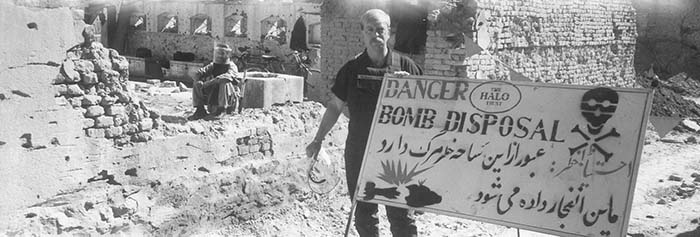Rob Krott in de-mining gear in Kabul.
by Rob Krott
“. . . we have always had our dream, freedom, self-determination, a voice in our future — this is the Kurdish dream. We have come so close but so many things conspire against us, and now these mines, this blight in our fields – they will surely kill our dream, even if we are successful in all our other efforts.”
– Kurdish Author Hussain Arif, Suleimaniya
Kurdistan, September 1991
Author’s Note: Information in this article was collected from friends in the de-mining field, military intelligence, and ordnance experts. Published references include Mines Advisory Group notes; “Interview of National Ground Intelligence Center Mine Warfare Expert,” January 15, 1998; October 1992 report by Rae McGrath, director of the Mines Advisory Group, for Middle East Watch (Division of Human Rights Watch); and the Iraqi Armed Forces Manual for the Tactical Use of Weapons of Mass Destruction, Official Special Manual No.469, Volume Two, Part One, December 1987. Any errors are solely the author’s. This information is presented with hopes that it may be disseminated (SAR is sending copies to the troops) and may prevent at least one Coalition Soldier from injury. Reading this does not make you an expert. Leave it alone, call EOD, it’s their job and they actually like it. As a platoon sergeant once told me, “Don’t pick it up and for damn sure don’t kick it.”
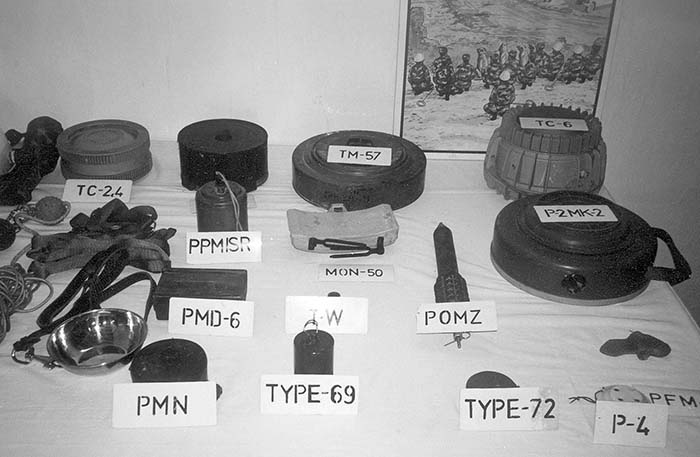
History of Iraqi Landmines
Iraq has been severely affected by mines and unexploded ordnance (UXO) as a result of the 1991 Gulf War, the 1980-1988 Iraq-Iran War, two decades of internal conflict, and even World War II. (Table 1 lists the mines found in Iraq’s minefields). Landmines and UXO pose a problem in the north, along the Iran-Iraq border, and throughout the central and southern regions of the country. The number of mines planted in Iraq is not known but it is in the millions. The Army of Iraq used mines in Kuwait in 1990-1991, during the Iraq-Iran War both inside Iraq and in Iran, and during internal conflicts, especially in the Kurdish areas of northern Iraq. The majority of the minefields in the region were laid during the Iran-Iraq War of 1980-88; and Iraqi forces laid others in military activities against the region’s Kurds. The mine problem in Northern Iraq (Iraqi Kurdistan), which has been autonomous from Baghdad since the 1991 Gulf War, is very serious. One Iraqi use of mines was to combat the Kurdistan Worker’s Party (PKK) in Northern Iraq and in the 1990’s as part of the Iraqi Government’s Anfal campaign, a forcible resettlement program where villagers were forced into collective towns and their villages mined to prevent return. Landmines and large quantities of UXO were scattered across the region. Since 1992 these weapons have resulted in 6,000 reported injuries and 3,350 reported deaths. In Kurdistan about one person a day steps on a mine or is injured by UXO. Many more mine incidents are believed to go unreported.
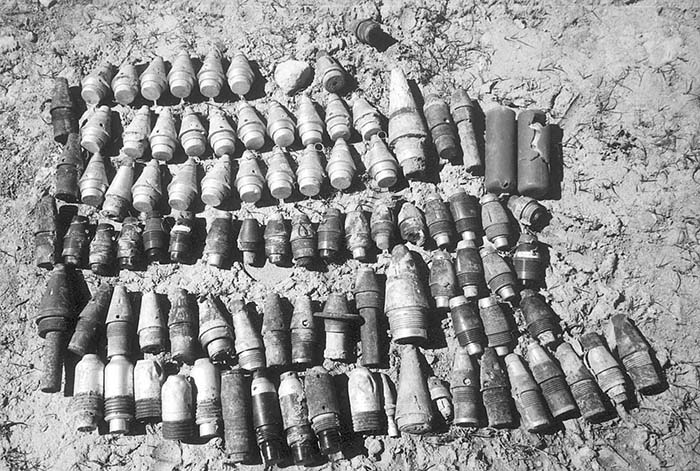
The US used 117,634 landmines in Iraq and Kuwait during the 1991 Gulf War. Of these, 27,967 were antipersonnel mines and 89,667 were anti-vehicle mines. US Air Force, Navy, and Marine Corps aircraft used Gator cluster bomb units to deliver these mines, while the Marine Corps used a small number of artillery-delivered mines. Landmines were identified as the cause of eighty-one US military casualties during the 1991 Gulf War. A recent study by the US General Accounting Office cited reluctance among some US commanders to use mines because of their impact on mobility, fratricidal potential, and safety concerns. US forces currently have at least 90,000 antipersonnel mines deployed in the Persian Gulf region.
Iraq has been both a producer (Iraq began producing mines in the 1970s) and an exporter of landmines and is believed to still possess a significant stockpile of mines. While there are no indications that export activity continued recently, Iraq is the only known mine exporter in the world that has not instituted an export ban or moratorium, or at least made a policy declaration of no current export.
Mines Used in Iraq
The most commonly encountered mines in Kurdistan are the Valmara 69 – called the Broom by Iraqi mine layers – and the VS-50. The SB-33 and PMN-HGE are also very common. The PMN-HGE is a derivative of the well-known Soviet PMN while the other three are Italian designs (some mines of Italian origin and/or design, chiefly the Valmara-69, the VS-50 and the SB-33, may have been assembled or manufactured in other countries, including Iraq). Mines laid by Iraq in northern Iraq and in Kuwait, or found in Iraqi stocks, originated from many countries including: Belgium, Canada, Czechoslovakia, Chile, China, Egypt, France, Jordan, Italy, Romania, Singapore, the former Soviet Union, United Kingdom, and the United States.
The PMN, sometimes referred to as PMN-1 to differentiate it from the later and more advanced PMN-2, is a Soviet-designed and manufactured anti-personnel, pressure-activated blast mine. Most PMN’s disseminated in Kurdistan have been manufactured in Iraqi State factories. The mine, as found in Kurdistan and designated PMN-HGE by the Iraqis, is a copy of the original Soviet mine. It was displayed as an Iraq-manufactured mine at the Baghdad Arms Fair in May 1989. It differs from the Soviet version only in the method of securing the rubber pressure diaphragm to the thermoplastic casing of the mine. The Iraqi government manufactured and deployed PMN-HE mines during the Iran-Iraq conflict.
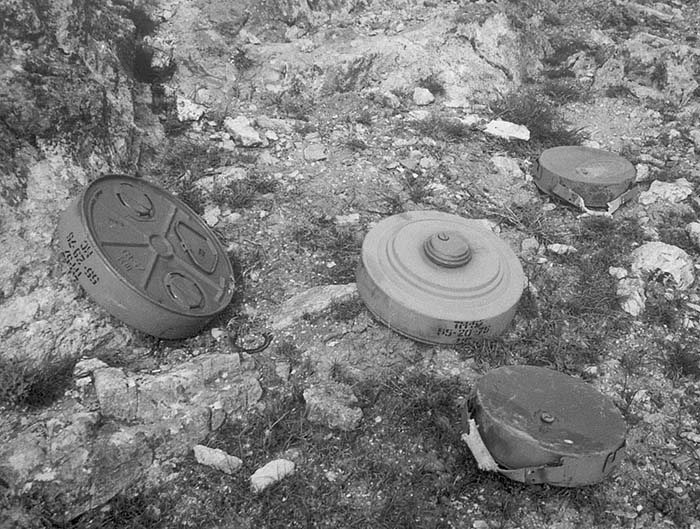
Iraq has produced Italian designed mines as well. The Valmara 69 and the VS-50 are designed and manufactured by Valsella Meccanotecnica SpA of Brescia, Italy – one of the world’s leading manufacturers and exporters of landmines. The Valmara 69 weighs in excess of 3 kilograms (6.6 pounds) – the main charge in all, or many, of the Valmara-69 and its derivatives used in Kurdistan, is surrounded by approximately 650 6mm diameter steel ball bearings. When activated by pressure or touch of a trip wire, Valmara-69 bounding fragmentation mines bound 1 meter in the air and detonate with a 35-meter lethal radius. People up to 100 meters away can receive severe injuries.
Because Valsella could not obtain an export license for Iraq it formed a new company in Singapore, which was not subject to an export ban, and obtained a license from the Italian government for export to that company. The mines were then re-exported to Iraq. In February 1991, seven executives of Valsella were convicted of illegally exporting nine million landmines to Iraq between 1982 and 1985. They received suspended prison sentences ranging from 18 to 22 months. At trial, The company’s defense was that the Italian government was fully informed of the arms sales to Iraq. {This was not the first time that Valsella was cited in connection with alleged illegal export of land mines through shell or foreign companies, as in September 1987, a Tuscan magistrate, Augusto Lama, told journalists that he had issued warrants against Valsella’s chairman and three executives of the company because he had documentary evidence that Valsella had illegally exported mines to Iran through Spanish, Turkish and Nigerian companies.)
With their source in trouble, Iraq began to manufacture copies of the Valsella mines. At the Baghdad Arms Fair in May 1989 the Iraqis displayed Valmara 69 bounding mines identical to those manufactured by Valsella but apparently manufactured in Iraq.
A Singapore-based company, Chartered Industries, partly owned and controlled by the Singapore government, also advertises devices identical to the Valmara 69 and the VS-50 as its own products; they are designated as VS-69 and VS-50 (also marketed as the SPM-1) by Chartered Industries. Another Italian mine used extensively in Iraq is the SB-33, described by its Italian manufacturers, BPD Difesa E Spazio of Rome, Italy to be a general-purpose, local action mine. The SB-33 is irregularly shaped, measures only 88mm in diameter, is just 32mm high, and has an anti-reflective surface (its dull green/grey finish is an effective camouflage against most natural backgrounds). Yet given Italy’s prohibition on arms exports to Iraq, it is not clear how so many SB-33’s found their way to the minefields of Kurdistan – though these mines are identical to the EM-20 marketed by the Elveiemek S.A., Hellenic Explosives & Ammunition Industry of Athens, Greece.
Besides Italian mines there are also Italian multi-purpose SAT mine fuses in Iraqi minefields. These fuses may be used to set off old or obsolete anti-tank mines by pressure or used as an anti-lift device. The fuses are coupled to buried anti-tank mines, which are not visible; although these may be MISAR SBP-04 or SBP-07, which were fitted with, SAT fuses. Originally manufactured by MISAR SpA of Brescia, Italy, in January 1990 the company was taken over by BPD Difesa e Spazio srl. of Rome who now market three devices in what they call the “SAT mine fuse family” – SAT/N, SAT/QZ and SAT/TL. The fuses are identical in appearance although they differ in explosive content and technical specification. Two models of the VS-3.6 and the VS-2.2, anti-tank mines are plastic devices employing the Valsella VS-N pressure fuse. These mines are frequently surface-laid and protected against removal by Valsella 69 and VS-50 anti-personnel mines.
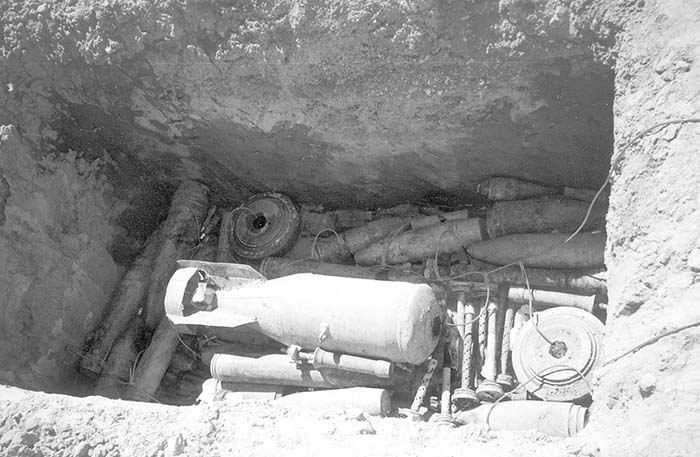
Miscellany
The Soviet VP-13, found in Iraq and other Middle East client states, incorporates “selectivity” – design features that avoid detonation by animals. Also found in Kurdistan were two, as yet unidentified, anti-personnel devices, believed to be of Iranian origin: one is a “stake” mine, probably of the fragmentation-type set off by tripwire, and the other is a small box-shaped mine of plastic construction which may be an Iranian pressure-release mine. Local reports and descriptions also indicate the presence of SB-33 and POMZ-2 landmines. A US M16-A2 bounding anti-personnel mine, indicating a possible Iranian minefield, was also recovered. The US M16 “bouncing betty” mines were supplied to the Shah of Iran’s army by the United States, and are not thought to have been a stock item in the Iraqi armory, though the Iraqis may have captured significant stocks and subsequently deployed.
Mortar and artillery rounds, including a 130mm artillery shell, have been used as improvised command-detonated mines. The 130mm round was buried on a slope so that when detonated it would disperse shrapnel a large distance to the front and sides of it. The normal impact fuse was removed and an electrical detonator surrounded by silicon gel inserted. This was then connected to a cable running back to an abandoned bunker 50 meters to the rear. Troops in the bunker could use a switch and electrical current to make the shell detonate on command.
Ansar Al Islam, an Islamic fundamentalist group with strong links to Al Qaeda, was based in the eastern part of northern Iraq, close to the Iranian border in Biyara, a few kilometers from Halabja. During Operation Iraqi Freedom a ground attack by Kurdish guerrillas, the Peshmerga (“the Undefeated”), was launched with the support of US forces. Many of the terrorists were killed or captured and others fled to the surrounding mountains. In the process of clearing up after the fighting, abandoned ammunition and booby traps were found in villagers’ homes taken over by the group. Mines Advisory Group (MAG) a British demining NGO, cleared a house in Deh Kon village, close to Halabja and used by Ansar Al Islam, removing 276 Chinese Type 72A anti-personnel mines and 4 mortar rounds.
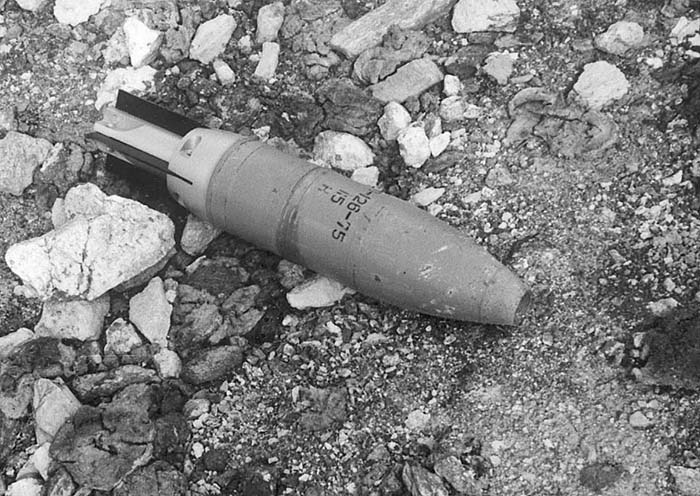
Operation Iraqi Freedomb
From the very beginning of Operation Iraqi Freedom there were reports of mine use by Iraqi forces near the Kuwaiti border, around Kirkuk in the north, and elsewhere. Iraqi troops laid anti-personnel mines in southern Iraq. There have been other reports that Iraqi forces were laying mines around Kirkuk in the north and elsewhere in the country. In the southern areas it appears that the mines, in most cases, were armed but deployed in a random and careless manner. Many Valmara 69 mines were not buried but linked in series on single tripwires. In one case, more than twelve devices were interlinked in this way. In the same area many VS-50 and other pressure devices were scattered at random – sometimes in groups of twenty or more. Some of these mines are unarmed. Other defensive minefields left over from the Iran-Iraq War consist of a more conventional pattern – predominantly of anti-personnel mines – Valsella 69, VS-50, and PMN-HE. Some are buried, others are surface laid, over wide, ill defined, and unmarked areas. Anti-tank mines, probably Soviet TM-46 or derivatives, PMN anti-personnel, and VS 1.6 (Valmara) anti-tank mines were laid in roadways by Iraqi troops. They dug holes in the asphalt and then covered the mines with tar.
Derband Gorge
During much of the Iran-Iraq war, Derband Gorge was the frontline between the opposing forces, and was the scene of some of the most violent engagements of the war. Because of the gorge’s strategic importance a significant concentration of mines and a high incidence of particularly hazardous napalm devices were laid there. The Derband minefield contains booby-traps consisting of 20-liter steel drums of napalm (jellied gasoline made from naphthalene and coconut oil). The drums have an explosive charge and are detonated by pull-ignition fuses connected to tripwires. The tripwires forming part of the initiation circuit are also connected to bounding mines and in some cases the napalm drums are interlinked with tripwire-activated mines. The napalm containers are, in most cases, buried, leaving the upper 25% of the drum exposed. In several instances, however, the drum is totally buried leaving only the top exposed at ground level.
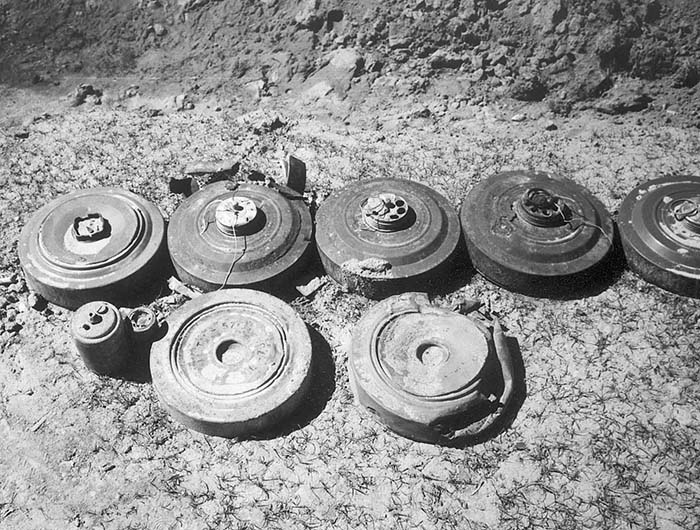
Chemical Mines?
Before the Gulf War, the Defense Intelligence Agency believed that Iraq’s ground forces possibly had chemical mines. This analysis was based on two pieces of information. Firstly, a Canadian soldier assigned to a United Nations’ peacekeeping force after the Iran-Iraq War thought he identified an Iraqi mine filled with chemical warfare agent in a conventional minefield along the Iran-Iraq border. It was recovered, however, and positively identified as a conventional mine. The second circumstance that caused concern in the US intelligence community began with an explosives shortage in Italy in the mid-1980s that led to the production of unfilled mine bodies. The US intelligence community was concerned nations such as Iraq, which had used many Italian-produced mines, would fill these mine bodies with chemical warfare agents. This fear proved unfounded. UNSCOM discovered no chemical mines in its post-war inspection and destruction of Iraq’s chemical weapons.
After the war, contractors for Kuwait collected and destroyed more than 3.5 million mines, none chemical, inside Kuwait. In addition, coalition forces captured and translated many of Iraq’s documents. Except for theoretical discussions, none addressed chemical mines. One of Iraq’s captured engineering publications discusses clearing an area of enemy chemical mines, using a US M21 chemical mine as an example.
After traveling 300 kilometers along the Gulf War front looking for signs of booby traps or chemical mines, a US expert found none.

Iraqi Minefield Doctrine
Iraqi engineers strictly implemented their doctrine for mine-laying operations. A US expert on foreign mines stated he felt very safe in an Iraqi minefield due to their discipline in following doctrine. However, reading interviews with Iraqi engineers makes me think differently. Iraqi sappers or engineers placed three anti-personnel mines 1 meter from an anti-tank mine with 4 to 5 meters separating each anti-tank mine. During the Gulf War, Iraqi combat engineers consistently followed this doctrine across its entire 400 kilometers of minefields. In a minefield near the Turkish border a random sample section 15×10 meters contained 31 PMN-HGEs, six Valmara 69s and two TM-46 anti-tank mines. There were also seven PMN-HGEs that were either unarmed or inoperative for other reasons. All anti-personnel devices were surface laid. The occasional standard mine marker is visible in these minefields and others may be present.
A September 1991 interview with an Iraqi Istikhbarat (military intelligence) officer attached to a Divisional Engineer Unit (with responsibility for a section of the defenses along the Iraqi-Turkish border prior to the Gulf conflict) revealed more on how the Iraqis laid mines. When asked if he had any idea how many mines were laid he answered, “I doubt if anyone would have an exact answer, except maybe the ordnance supply quartermaster in Mosul. This is how big it was – for four months we laid mines throughout the front, every day – there simply weren’t enough military trucks to bring them from the stores in Mosul so civilian vehicles were used as well.” Responding to questions on record keeping he replied, “I never saw any maps. We, the officers, knew where the mines were meant to be laid and those instructions were passed down to the sappers. No, I don’t think any maps were made.”
An interview conducted at the same time with an Iraqi Army divisional sapper unit section commander, one of 2,500 soldiers involved in the same mine-laying operation as the Istikhbarat officer, refutes the assertion that the Iraqis were disciplined minelayers. (see Sidebar) According to the squad leader: no maps or sketches of the minefields were made; the officers kept no records or maps as the minelayers were too busy; only a count of the mines laid was kept – usually about 5,000 a day by his squad alone; faulty mines and mines without detonators were laid; and mines were laid without arming or merely surface laid due to laziness. So much for discipline.
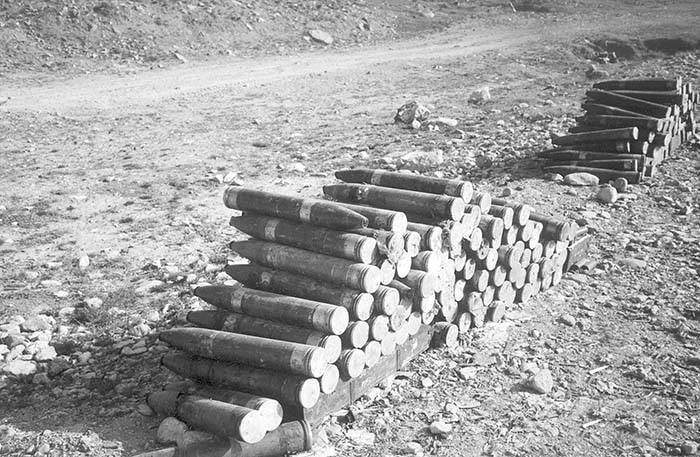
De-mining and Clearance
Kurdish Peshmerga military forces have cleared mines from roads in Iraqi Kurdistan by hand, locating them by using probes. Only in northern Iraq has there been organized mine clearance where humanitarian mine action programs are conducted in the northern provinces or governorates of Sulaymaniya, Erbil, and Dohuk. It is estimated that funding for mine action in northern Iraq totaled about $80 million from 1993 to 2001. The Iraq Mine Action Program, under the jurisdiction of the United Nations, is funded entirely through the UN Oil for Food Program, which started in 1997. Two key mine action NGOs, Mines Advisory Group (MAG) and Norwegian People’s Aid (NPA), receive funds apart from the UN program, totaling about $2.4 million in 2001. The Mines Advisory Group is a United Kingdom-based agency specializing in the design of mine survey techniques and the establishment of humanitarian landmine eradication programs. MAG began operations in 1992 in the Kurdish controlled region of northern Iraq In 2001. MAG and NPA cleared more than 1 million square meters of land. Mine clearance efforts in the rest of the country prior to Operation Iraqi Freedom remain unknown.
For more information on MAG contact:
Mines Advisory Group
47 Newton Street
Manchester M1 1FT
United Kingdom,
TEL: +44 [0] 161 236 4311
FAX: INT +44 [0] 161 236 6244
email: maguk@mag.org.uk
| This article first appeared in Small Arms Review V7N7 (April 2004) |



